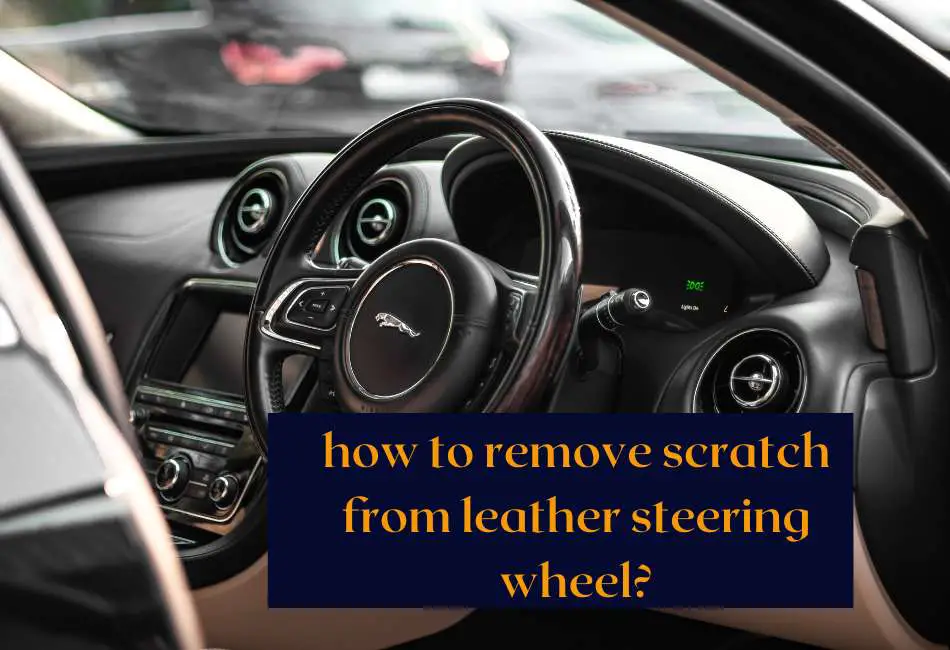When it comes to the aesthetics and appeal of your vehicle’s interior, the condition of your leather steering wheel plays a significant role.
A scratch-free leather steering wheel enhances the overall look and provides a comfortable and enjoyable driving experience.
Over time, however, even the most meticulous drivers may notice scratches on their steering wheel due to common factors such as sharp objects, direct sunlight, or repeated use. Understanding these causes is the first step toward effective prevention and repair.
Understanding Leather Types
Before we dive into removing scratches, it’s important to understand the different types of leather used in steering wheels.
Knowing the type of leather can greatly influence the methods we use for scratch removal.
Different types of leather used in steering wheels
- Full-grain leather:
This is the highest quality of leather, and it’s what I have in my car. It’s incredibly durable and resistant to moisture. Over time, full-grain leather develops a natural patina that adds to its appeal.
- Top-grain leather:
This type of leather is similar to full-grain but has been sanded and buffed to remove imperfections. My neighbor’s car has a top-grain leather steering wheel, which still looks fantastic even after years of use.
- Genuine leather:
This is the most common type of leather used in steering wheels. It’s not as high-quality as full-grain or top-grain leather, but more affordable. My good friend, Mike, has a car with a genuine leather steering wheel and is really happy with it.
Knowing the type of leather used in your steering wheel is crucial for proper scratch removal. Each type of leather requires a different approach to care and repair, which is why it’s so important to identify it correctly. For example, full-grain leather requires less frequent conditioning than genuine leather.
Ways to Remove Scratches
1. Conditioning and Moisturizing
Conditioning leather is essential to maintain its luster and prevent it from drying out and cracking. I remember using a conditioner on my first car’s leather steering wheel, and the results were astonishing.
Moisturizing leather is straightforward. Apply a small moisturizer to a soft cloth and gently rub it into the leather. I do this at least once a month for my car, and it helps keep the steering wheel soft and supple.
Many great products are on the market. I like to use “Leather Honey” for conditioning and moisturizing, I swear by “Chemical Guys Leather Conditioner and Cleaner.”
I’ve found that these products offer excellent results and preserve the life of my leather steering wheel.
DIY Solutions
Sometimes, a homemade solution can be just as effective for minor scratches on your leather steering wheel. Here are three DIY methods I’ve used with good results:
2. Olive Oil and Vinegar Mixture
I remember when my grandmother told me about the magic of olive oil and vinegar for cleaning. Just mix one part of vinegar with two parts of olive oil, and voila!
You’ve got yourself a homemade leather scratch remover. I wear it with a soft cloth, which always works like a charm.
3. Baking Soda Paste
Sounds weird, doesn’t it? But baking soda paste is another phenomenal DIY solution for dealing with scratches.
Mix equal parts baking soda with water to form a paste, apply it to the affected area, let it sit for a few minutes, and then wipe it off. I was amazed at the results the first time I tried it!
3. Lemon Juice and Cream of Tartar Blend
This method saved the day when I accidentally scratched my steering wheel with my keys. Make a paste of lemon juice and cream of tartar (equal parts), and apply it to the scratches.
Leave it for a few hours, then wipe it off. I was initially skeptical, but the results were nothing short of impressive!
Application Guide for DIY Solutions
- Clean the scratched area with a soft cloth.
- Apply your chosen DIY solution to the affected area.
- Leave the solution in place for the stipulated time.
- Wipe it off with a clean cloth.
Commercial Leather Repair Kits
Sometimes, you need something a bit more potent than a homemade solution. That’s where commercial leather repair kits come into play.
There are numerous leather repair kits available on the market.
I’ve tried and recommended the “LeatherNu Complete Leather Color Restoration & Repair Kit” and the “Furniture Clinic Leather Easy Restoration Kit.”
They come with everything you need, including instructions, to make your steering wheel look new.
Step-by-Step Guide on Using Commercial Kits
- Clean the scratch with a leather cleaner.
- Apply the repair compound from the kit to the scratch.
- Let the compound dry.
- Apply the colorant matching your steering wheel’s color.
- Let it dry.
Pros and Cons of Using Commercial Solutions
Commercial solutions are often more effective and faster than DIY solutions. They’re designed specifically for leather, so they work well.
However, they’re more expensive than DIY methods. And while they usually come with instructions, they can still be tricky. But with my share of trials and errors, I’ve become a pro at this!
Professional Repair Services
Sometimes, despite your best efforts, the scratches on your steering wheel might be too severe for DIY or commercial solutions.
That’s when professional leather repair services come into play. I once had a deep gash on my steering wheel that no home solution could fix, so I called the pros.
When Professional Services are Necessary
If your steering wheel has deep cuts or if the color is severely faded, it’s time to consider professional help. Professionals have the tools and expertise to restore your steering wheel to its former glory.
Researching and Selecting a Reputable Leather Repair Professional
Finding a reputable professional is crucial. I researched extensively, looked up reviews, and asked friends before selecting a professional. Getting multiple quotes and choosing someone with a proven track record is always a good idea.
Cost Considerations and Potential Outcomes of Professional Repair
Bear in mind that professional services can be costly. However, the results can be impressive. My steering wheel was expertly repaired and looked as good as new!
Preventive Measures
Prevention is always better than a cure. If I knew then what I know now, I might have prevented that gash on my steering wheel!
Use of Steering Wheel Covers
Steering wheel covers are a great way to protect your steering wheel from scratches.
- Benefits of Steering Wheel Covers
They provide a protective layer and prevent direct contact with the leather, reducing the potential for damage.
I have noticed a significant reduction in scratches since I started using one.
- Different Types of Covers Available in the Market
There’s a variety of steering wheel covers available, from plush fabric ones to sleek leather ones. I chose a leather cover that matched my car’s interior.
- Proper Installation and Maintenance of Covers
Installing a cover can be a bit tricky, but take your time to ensure it fits snugly. Regularly clean the cover to keep it in good condition.
Regular Cleaning and Maintenance
Regular cleaning and maintenance are key to keeping your leather steering wheel looking new.
- Importance of Routine Cleaning
Dirt and grime can cause the leather to degrade over time. Regular cleaning can help maintain its look and feel.
- Recommended Cleaning Products and Techniques
I recommend a gentle leather cleaner. A soft cloth and a light touch can prevent further scratches during cleaning.
- Establishing a Regular Maintenance Schedule
Set a regular maintenance schedule and stick to it. I clean my steering wheel once a month.
Conclusion
A well-maintained steering wheel can enhance the look and feel of your car.
Whether you choose DIY solutions, commercial kits, or professional services, it’s crucial to address scratches promptly.
Regular cleaning and the use of steering wheel covers can help prevent scratches. Remember, a stitch in time saves nine. Here’s to happy, scratch-free driving!

